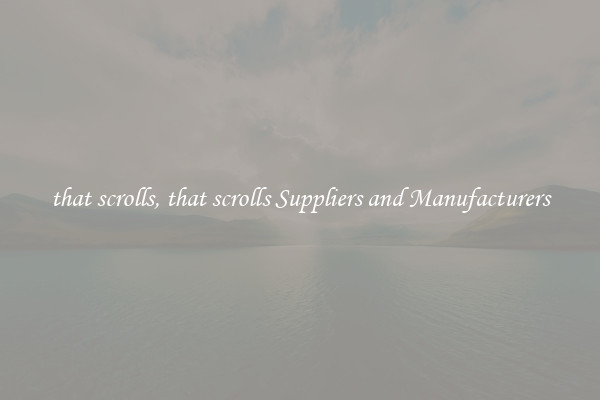that scrolls, that scrolls Suppliers and Manufacturers
Scrolls have played a significant role throughout history, whether it be for recording important information, religious texts, or even artistic expressions. With the advancement of technology, the act of physically scrolling through these ancient artifacts has become less common. However, the demand for scrolls and the suppliers and manufacturers who create them have not diminished.

The art of scroll making requires skilled craftsmanship and attention to detail. This has led to the emergence of a niche market for scroll suppliers and manufacturers, catering to individuals and organizations alike who appreciate the historical value and aesthetic beauty of scrolls.
Suppliers of scrolls source their materials meticulously, ensuring that they adhere to the highest quality standards. Fine, durable paper or parchment is selected, often imported from specialized regions known for producing high-quality paper. In addition to paper, suppliers may source unique materials like silk, bamboo, or even gold-plated fabrics, depending on the specific requirements of the client.
Manufacturers, on the other hand, employ the use of traditional tools and techniques to create scrolls. Skilled artisans carefully handcraft each scroll, paying close attention to every detail of the construction process. This includes meticulously cutting and shaping the materials, applying adhesives and finishes, and hand-painting intricate designs or calligraphy on the scrolls. The result is a work of art that exemplifies the timeless beauty and craftsmanship of ancient scrolls.
While scrolls were historically used for religious texts or official records, they have also found their place in the modern world. Today, scrolls are often used for decorative purposes, adding an elegant touch to interior design. They can be displayed in homes, offices, or museums, acting as captivating focal points that evoke a sense of history and culture.
With the rise of digitalization, scrolls have also found their way into the virtual realm. Digital scroll replicas are created through advanced scanning and 3D modeling technologies, ensuring every detail of the original is captured and reproduced. These digital scrolls provide an opportunity for wider access and preservation of historic texts and documents, combining the authenticity of traditional scrolls with the convenience of digital devices.
In conclusion, though scrolls may seem like relics of the past, the demand for their creation continues to flourish. Scroll suppliers and manufacturers play a crucial role in preserving this ancient art form by sourcing high-quality materials and employing time-honored techniques to create beautiful scrolls. Whether used for religious, decorative, or virtual purposes, scrolls serve as tangible reminders of our rich history and cultural heritage.

View details

View details

View details

View details








